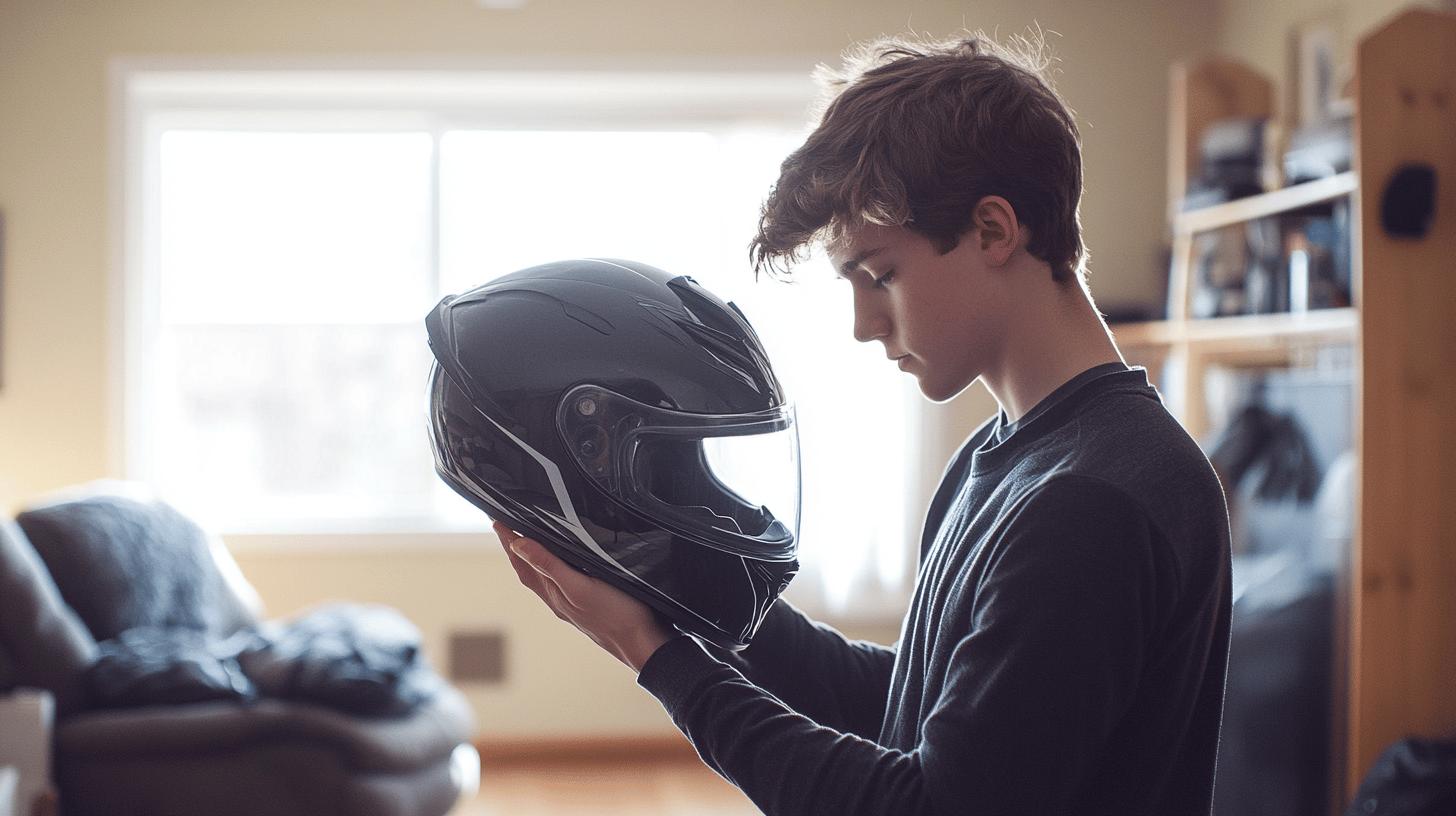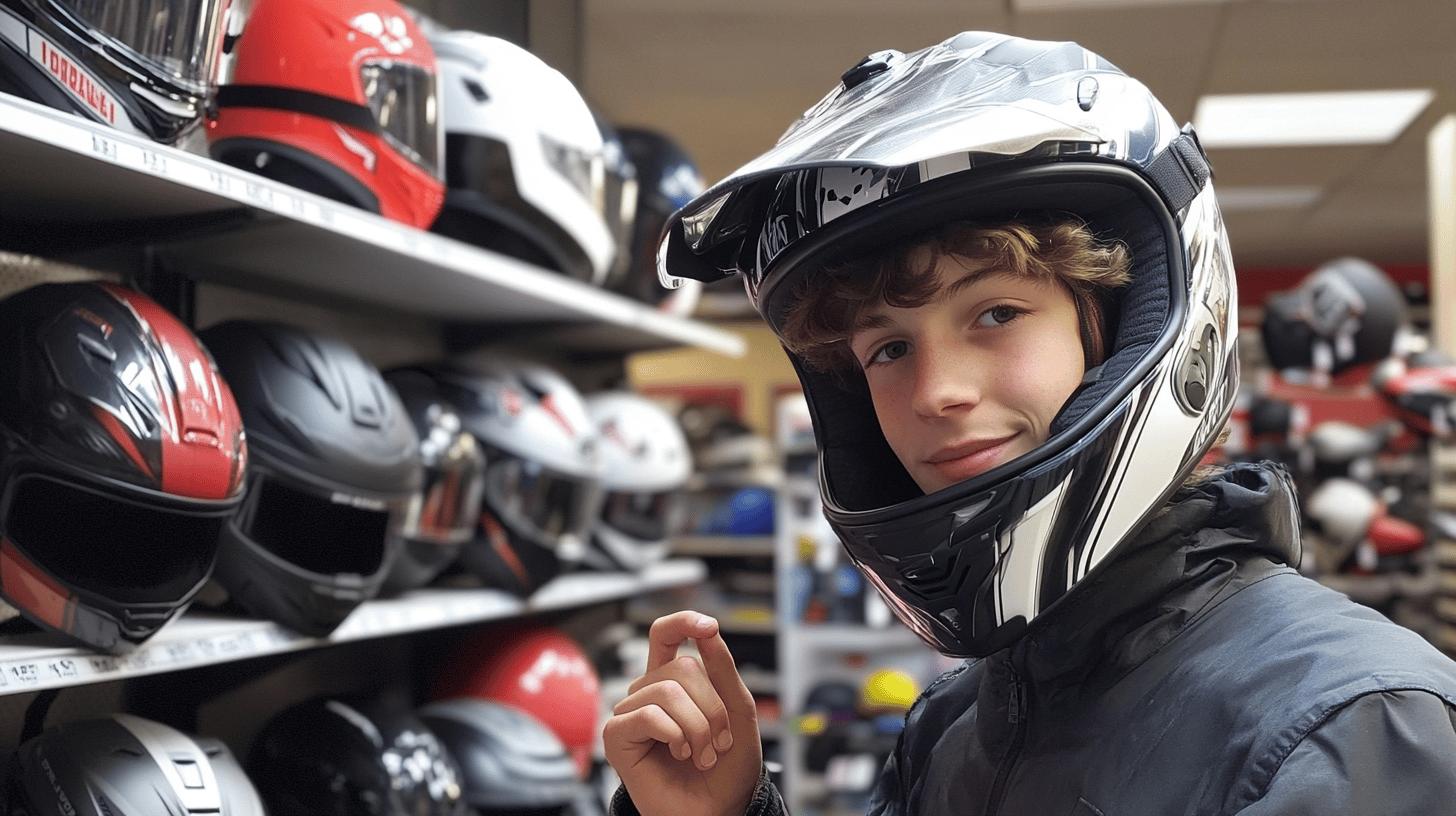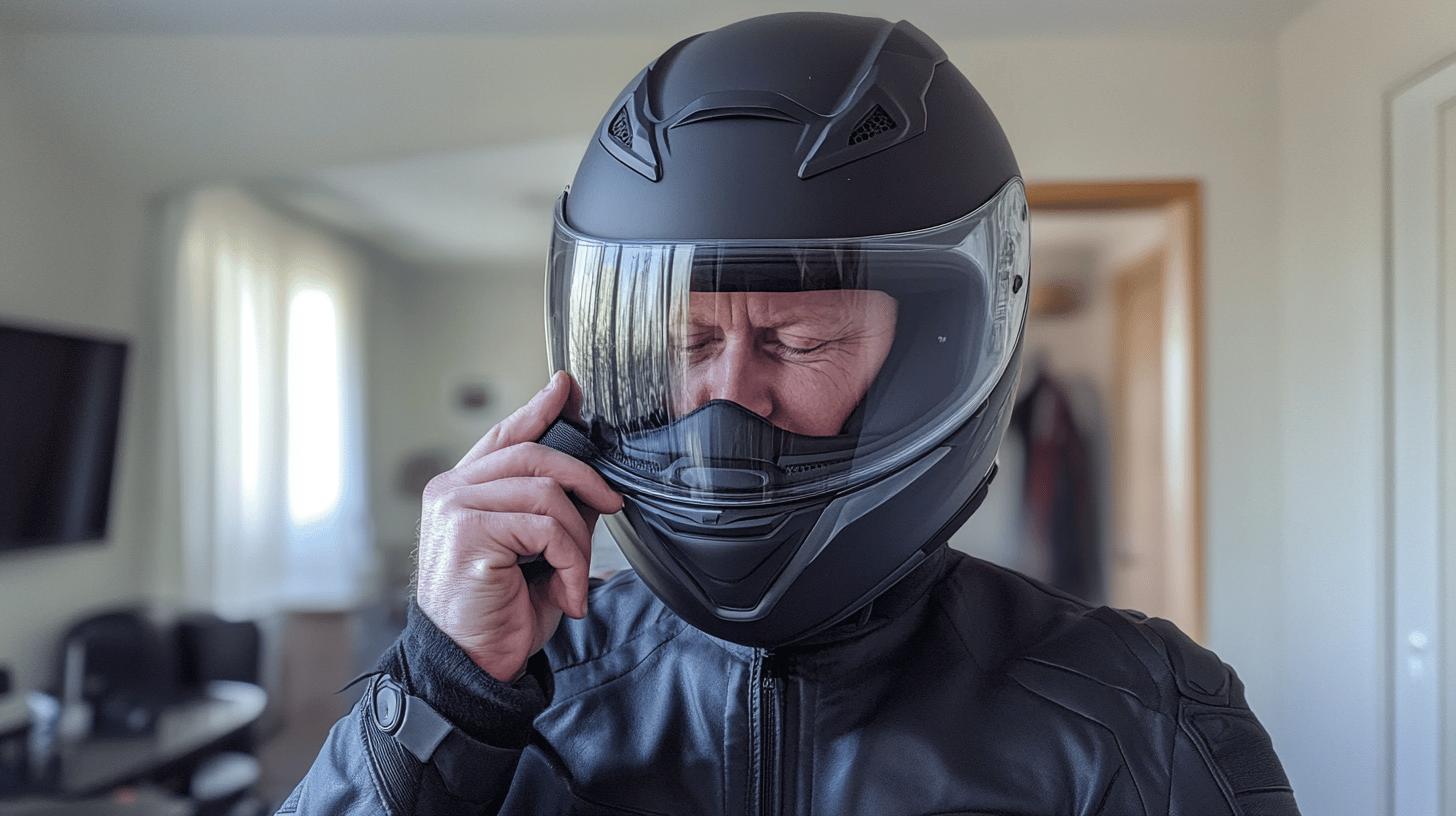Think you've got an unusual head shape that makes finding the right motorcycle helmet a daunting task? You're not alone. Understanding your head shape is critical for both comfort and safety when selecting a helmet.
Many riders are surprised to learn that their head shape usually fits within three basic categories: round oval, intermediate oval, or long oval. With the right knowledge, selecting the perfect helmet becomes a straightforward process that enhances your riding experience.
This guide will help demystify head shape identification and ensure you find a helmet that fits like a glove, promoting safety and comfort on every ride.
Understanding Your Head Shape for Helmet Fit

Determining your head shape is a critical step in selecting a motorcycle helmet, as it directly impacts both comfort and safety. A helmet that matches your head shape will distribute impact forces more evenly, reducing the risk of injury.
Additionally, a well-fitting helmet enhances riding comfort by minimizing pressure points and preventing unwanted movement during rides. Helmets are typically designed to accommodate specific head shapes, so identifying your shape ensures you choose a model that fits snugly and securely.
-
Round Oval: This shape is almost as wide as it is long, resembling a circle when viewed from above.
-
Intermediate Oval: The most common head shape, it is slightly longer than it is wide, forming an oval that is not overly pronounced.
-
Long Oval: This shape is noticeably longer front to back than it is side to side, similar to a football.
Many riders express concern over having an "odd-shaped" head, but this is often a misconception. Most head shapes can be categorized into the three standard types: round oval, intermediate oval, and long oval.
The perception of uniqueness often arises from the subjective nature of self-assessment. By understanding that these categories cover the vast majority of individuals, riders can approach helmet selection with greater confidence, ensuring a fit that offers both protection and comfort.
Measuring Your Head for Helmet Sizing

Accurate head shape measurements are fundamental in selecting a motorcycle helmet that provides both safety and comfort. A helmet that fits correctly not only protects the rider during impacts but also enhances the overall riding experience by ensuring stability and avoiding discomfort.
Incorrect sizing can lead to pressure points or excessive movement, compromising safety and detracting from the riding experience. Therefore, understanding how to measure your head accurately is the first step in the helmet sizing guide.
To measure your head circumference, begin by using a tailor's tape, which is flexible and ideal for capturing rounded measurements. Position the tape about an inch above your eyebrows, ensuring it wraps evenly around the largest part of your head.
This typically aligns with the point where your head is widest. Make sure the tape is snug but not too tight, as this will provide an accurate reading. Record the measurement in both inches and centimeters, as helmet sizing charts may use either unit of measurement.
| Measurement Step | Description |
|---|---|
| Select a Measuring Tool | Use a flexible tailor’s tape for accuracy. |
| Position the Tape | Place the tape an inch above your eyebrows, around the largest part of the head. |
| Ensure Even Wrapping | Make sure the tape is level and not twisted, snug but comfortable. |
| Record the Measurement | Note the circumference in inches and centimeters. |
These measurements are translated into helmet sizes using manufacturer-specific sizing charts. Each brand might have slight variations in measurements, so it's crucial to compare your recorded measurements with the sizing chart of the specific helmet brand you are considering.
This ensures the helmet will fit your head shape properly, providing both safety and comfort. Choosing the right size based on precise measurements reduces the likelihood of needing adjustments or exchanges, streamlining the helmet purchasing process.
Analyzing Your Head Shape with Photos and Mirrors

Using visual aids such as photos and mirrors can significantly enhance the process of determining your head shape for a motorcycle helmet. What makes these tools valuable? Photos and mirrors provide a clear and objective view, allowing riders to assess the contours and dimensions of their head more accurately.
When you look directly in a mirror or analyze a photograph, particularly a selfie taken from above, you'll gain a perspective that removes the guesswork often involved in self-assessment. This method is especially useful for those who find it challenging to categorize their head shape into the standard types.
-
Find Good Lighting: Ensure you're in a well-lit area to reduce shadows that might distort your view.
-
Use a Mirror: Stand in front of a mirror and look straight ahead to observe your head's outline.
-
Take a Selfie: Capture a selfie from above, aiming to get as much of the top of your head as possible.
-
Ask a Friend: Have a friend take a photo of your head from above for a different perspective.
-
Compare Images: Analyze the images to identify the overall shape and compare with standard head shape categories.
Once you have your photos, the next step is interpretation. Look closely at the images to determine whether your head shape resembles a round oval, intermediate oval, or long oval.
By comparing the top view of your head with these categories, you can pinpoint your head shape with greater precision. This insight is crucial for selecting a helmet that not only fits well but also offers maximum protection and comfort during rides.
Matching Helmet Types to Your Head Shape

Motorcycle helmets come in various styles, each designed to offer different levels of protection and coverage tailored to specific riding needs. The most common helmet styles include full face, open face, modular, and half helmets.
Full face helmets provide the maximum coverage, protecting the entire head and face, making them ideal for high-speed or long-distance riding. Open face helmets offer less coverage, leaving the face exposed, but still protect the top and sides of the head.
Modular helmets combine features of both full face and open face designs, allowing riders to flip up the chin bar for convenience. Half helmets, often used for short rides or in less demanding environments, offer minimal coverage, protecting only the top of the head.
-
Round Oval: Best suited for open face and modular helmets, which provide comfort without excessive pressure on the sides.
-
Intermediate Oval: Compatible with most helmet styles, including full face and modular, due to its balanced proportions.
-
Long Oval: Ideally fits full face helmets, which accommodate the elongated shape with added chin and forehead room.
- Custom Adjustments: Some riders may require adjusted padding within any helmet style to achieve the perfect fit.
Trying on helmets is a crucial step in ensuring both comfort and safety. Even after identifying your head shape, variations in helmet brands and models can affect fit. A helmet should feel snug without being too tight, ensuring it stays securely in place without causing discomfort.
During a fitting, it's important to perform movement tests, such as turning your head side to side and nodding, to ensure the helmet does not shift independently. By testing different models and making necessary adjustments, riders can achieve a fit that maximizes both protection and comfort, enhancing the overall riding experience.
Common Helmet Fit Mistakes and How to Avoid Them

Many riders encounter helmet fitting issues, often due to misconceptions about head shape and improper sizing techniques. A prevalent mistake is assuming one has an "odd-shaped" head, which can lead to choosing the wrong helmet style or size. This concern is usually unfounded, as most head shapes fall into common categories.
Another frequent error is neglecting the importance of snugness; a helmet that feels too loose compromises safety by moving around and failing to protect effectively in an accident. Additionally, some riders overlook the necessity of trying on helmets with different padding configurations, which can result in pressure points or discomfort during long rides.
-
Measure your head accurately using a flexible tape measure.
-
Identify your head shape: round oval, intermediate oval, or long oval.
-
Try on several helmets, focusing on the fit and comfort.
-
Perform movement tests: the helmet should not shift independently.
-
Adjust padding or straps to ensure a snug fit.
Ensuring a proper helmet fit is crucial for rider safety and comfort. Helmets that fit well provide optimal protection by distributing impact forces evenly. A well-fitted helmet also minimizes distractions caused by discomfort or movement during a ride.
Riders should prioritize fit over style, remembering that a secure helmet is a key component of motorcycle safety. Conducting movement tests and making necessary adjustments are essential steps in achieving a fit that enhances both safety and the riding experience.
Helmet Fit Tests and Adjustments

Ensuring a proper helmet fit is paramount for rider safety and comfort. A helmet that fits well will effectively protect the rider's head by evenly distributing impact forces. Fit tests are essential to verify that the helmet stays securely in place during movement.
These tests help identify any areas where the helmet might be too loose or tight, which could compromise safety. A well-fitted helmet should provide a snug feel without causing discomfort or excessive pressure. By conducting fit tests, riders can determine if adjustments are needed, such as tightening the chin strap or replacing interior padding.
-
Movement Test: With the helmet on, shake your head side to side and nod up and down. The helmet should not move independently of your head.
-
Chin Strap Adjustment: Fasten the chin strap securely. If the helmet moves during the movement test, tighten the strap further.
-
Padding Check: Inspect the interior padding. Adjust or replace it if the helmet feels uncomfortable or if there are pressure points.
- Size Reevaluation: If adjustments don’t stabilize the fit, consider trying a different helmet size.
If the helmet does not pass these fit tests, troubleshooting common fit issues is the next step. For example, a helmet that shifts during riding might be too large, requiring a smaller size.
Conversely, if pressure points cause discomfort, the helmet might be too tight, or the interior padding may need adjustment. If all adjustments fail to achieve a secure and comfortable fit, it might be necessary to explore different helmet sizes or styles that better accommodate your head shape.
Final Words
Grasping how to determine head shape for motorcycle helmet selection significantly enhances comfort and safety. The blog underscored the importance of head shape identification and measurement, providing step-by-step guides.
By employing techniques like photo analysis and understanding helmet types, riders can avoid common fitting mistakes. Trying different helmets remains key.
With the right approach, riders enjoy a safer and more comfortable riding experience, aligned with their unique head shapes.
FAQ
How do I know my head shape for a motorcycle helmet?
To determine head shape, examine the top view of your head using a mirror or a photo. Identifying as round, intermediate, or long oval is key for selecting the correct helmet.
How to measure head size for a helmet without tape?
Use a string as an alternative to a tailor’s tape. Wrap it an inch above your eyebrows and then measure the string against a ruler to get your head circumference.
What is the 2 2 2 rule when fitting a helmet on your head?
The 2 2 2 rule implies ensuring two fingers fit between the chinstrap and your chin, the helmet edge is two fingers above your eyebrows, and adjusting straps till comfortably tight.
How should a full face motorcycle helmet fit?
A full-face helmet should fit snugly without pressure points. Ensure the top is secure and doesn't move independently. Your cheeks should feel firm contact without excessive tightness.
Does head shape matter for helmets?
Head shape is crucial for helmet choice. Different shapes like round, intermediate, and long oval dictate comfort and fit, affecting helmet stability and safety.
How to tell if you have a round or oval head?
Assess your head from the crown perspective using a photo or mirror. A round head has equal width and length, while an oval head is longer than it is wide.
What are common helmet fit mistakes and how to avoid them?
Common mistakes include loose fit and incorrect size selection. Avoid them by measuring accurately, trying on various helmets, securing a snug fit, adjusting straps, and considering head shape.

Brad Mitchell is a seasoned motorcycle enthusiast with over 16 years of riding experience. He’s spent countless hours on the open road, particularly favoring scenic routes aboard his trusted Harley-Davidson. Brad’s laid-back approach to life and riding gives him a unique perspective on motorcycle gear and safety, which he shares through his in-depth reviews and expert advice on ProtectiveGearz.



